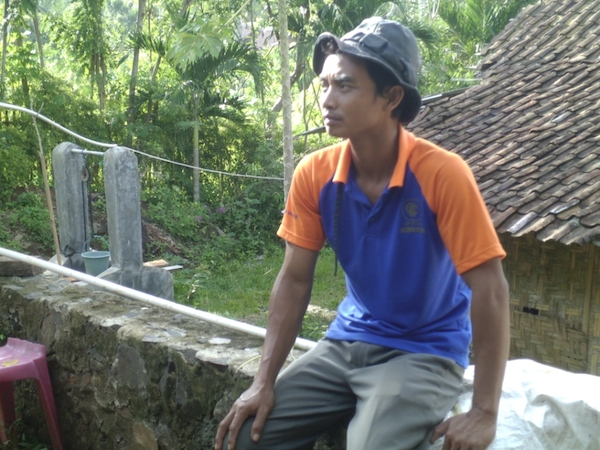CSR and our Biogas project
Host: Lisa Wood/ AGP Indonesia
Written by Lisa Wood – Traceability Officer, AGP.
Today’s post is about one of our Corporate Social Responsibility (CSR) projects. For those joining us this year, Indonesian Big Business must participate in projects that enhance the society in which we live and operate. These projects are varied and tailored for the needs of the area.
In the past schools and mosques have been built. Another ongoing project we have is with loaning PTIC heifers to local farmers. This means that the heifer has been pregnancy tested and is definitely in calf before we loan her.
The farmer looks after the heifer, keeping her healthy, and the reward is the calf which they can choose to keep or sell. This not only increases the local knowledge about how to raise cattle, it provides a boost to the farmer’s income.
From this project, we had two farmers that stood out from the crowd in terms of responsibility and success. When other farmers participating wanted to opt out, these two farmers put their hands up and asked if they could take on the extra cows rather than have them sent back to the feedlot.
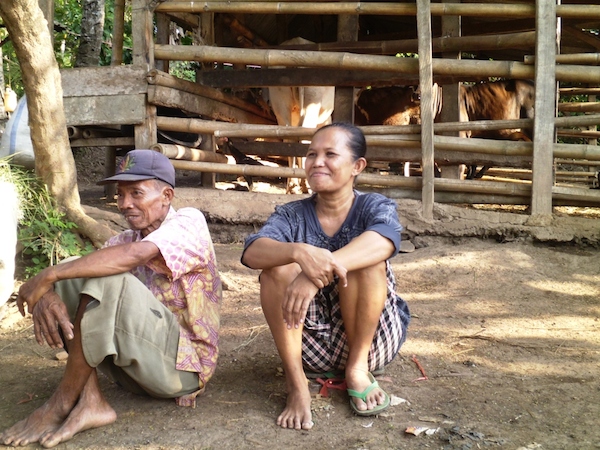 Pak Giwo and his phenomenal wife Ibu. She is a real dynamo.
Pak Giwo and his phenomenal wife Ibu. She is a real dynamo.
As we have reached the farmer interest capacity of loaning PTIC heifers, this year we looked for something new. Previously, I had met some farmers in Metro who have biogas reactors installed and they were very happy and complimentary with their systems, therefore I thought it may be a good project for us to install some. After passing the idea and details past the Bosses, they agreed in principle, as long as I could find the funds.
The next step was to grab Dr. Neny. Some may remember her from last year’s blog. Dr. Neny is our resident Feedlot Vet and visits the farmers every two weeks to check on the cattle, administer any medicine required, and answer any questions the farmers might have. I needed Dr Neny to help me explain to our farmers, tell them about biogas and ask if they would be interested in having reactors built for them. As the farmer will be using the cow manure to fill the biogas reactor, we needed to be sure of their interest and willingness first.
Ibu Giwo makes gula merah (red sugar) which gives them another commodity to sell from their farm. She uses the waste water from this process to feed to her cows, they love it – it’s a bit like molasses. In order to make the gula merah, she has to stand over a wood fire for three hours while she stirs the mix.
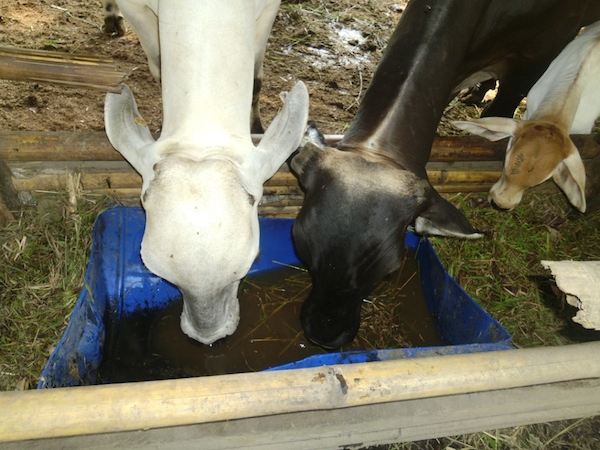 The Giwo family’s cows drinking the waste water from the gula merah making process.
The Giwo family’s cows drinking the waste water from the gula merah making process.
I’m pleased to say, they were interested. Next on my list was to search for funds. This past year has been very tight as we bounced back from the ban and the quota restrictions.
I am ever grateful to Austrex and Kentmaster for helping us to fund the construction of the biogas reactors; as well as the local and professional crews from BIRU in building them.
Do I hear a call of “Whoa, back up a bit. What’s a Biogas Reactor?”
A Biogas Reactor comprises of a mixer, a domed underground pit, a turret for the gas outlet, and a slurry pit. Essentially, smelly cow manure goes in; methane gas which can be used for cooking and lighting, as well as not smelly slurry, comes out. The slurry makes a fantastic fertilizer, and can be dried and compacted for use as fish food.
After a couple of hiccups – Pak Asep wanted to move his cattle pen and the Giwo family wanted to move house as their landlord wouldn’t allow them to have the reactor installed on his property, we were ready to start and construction was underway.
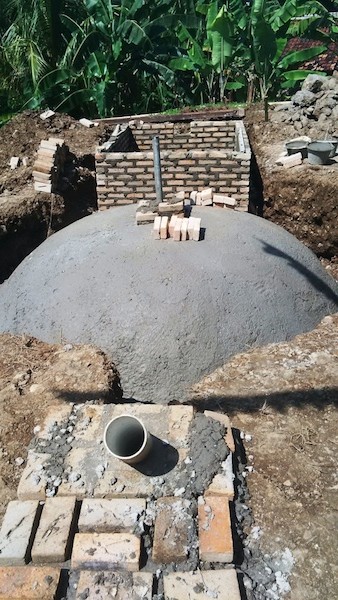 Construction of the reactor nearly complete at the new Giwo residence.
Construction of the reactor nearly complete at the new Giwo residence.
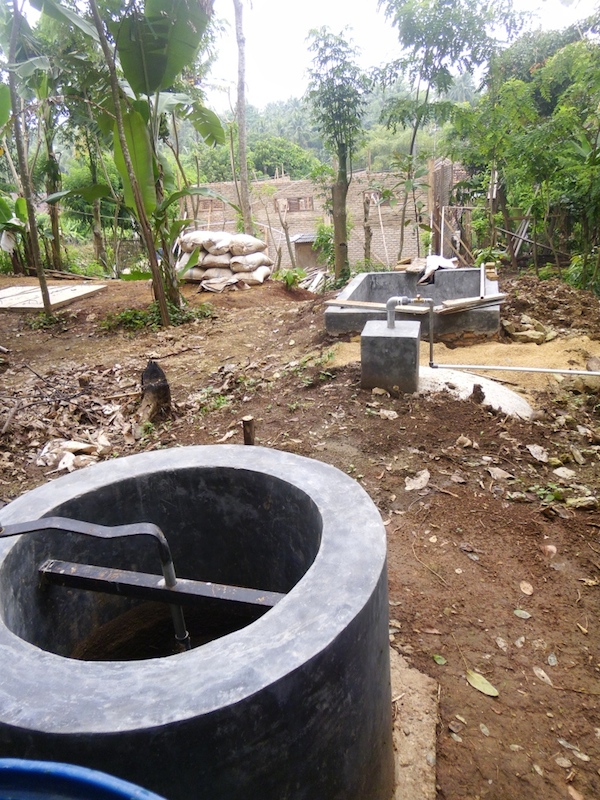 The completed reactor at Pak Asep’s house. He has built his wife a new kitchen to go with it.
The completed reactor at Pak Asep’s house. He has built his wife a new kitchen to go with it.
We were also able to build a biogas reactor at Way Laga. This supplies the plantation workers house with gas for cooking as well as a light inside for when the electricity fails. As we were able to build a larger reactor here, we installed a second gas stove for our cattle workers and a couple of lights as well.
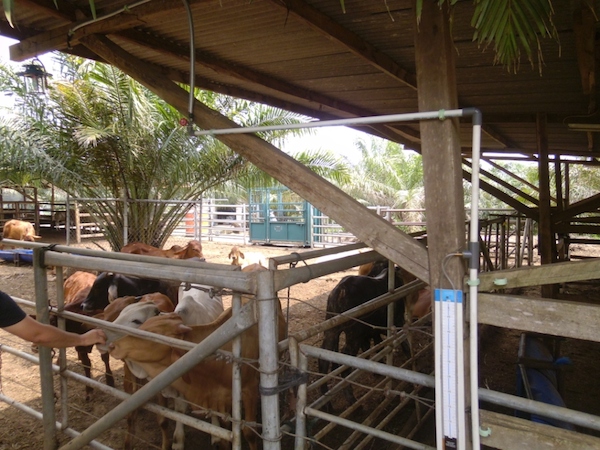 A biogas light at the Way Laga yard. The white rectangular thing with the blue band at the top with the plastic tube is the pressure indicator.
A biogas light at the Way Laga yard. The white rectangular thing with the blue band at the top with the plastic tube is the pressure indicator.
At the moment, I am waiting for the farmers and the Way Laga feedlot to fill their digesters with manure so they can start using the gas produced.
Anaerobic digesters and the use of biogas is something I would really love to see take off at a small scale for remote Australian stations. Six house cows, plus plumbing your toilet in as it can give free gas for about eight hours per day depending on your burner size. Beats the hell out of LPG in my mind (apologies to previous my work industry, but. . .)
I want to learn the average size of an Australian brick so we can do the conversion and then I can work out how much it would cost to build a 6m³ or 12m³ digester in Australian dollars. It is such simple technology proven with over 15 years use, even in Australia. I remember once upon a time someone saying to me that Australia was the most developed third world country. Have we overcome that?

